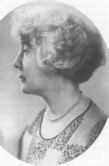Nationality African American Name May Jackson | Known for Sculptor Died 1931 | |
 | ||
Born September 7, 1877 ( 1877-09-07 ) Philadelphia Spouse(s) William Sherman Jackson Awards Harmon Foundation, 1928 | ||
May Howard Jackson (1877–1931) was an African American sculptor.
Contents
She was known as "one of the first black sculptors to ... deliberately use America's racial problems" as the theme of her art.
Early Life and Career
She was a student at J. Liberty Tadd's art school in Philadelphia, PA and in 1895 became the first African-American receiving a scholarship to attend The Pennsylvania Academy of the Fine Arts. She married a school principal, and moved to Washington, D.C. in 1902. She became a sculptor of portraits, and taught at Howard University. She did not travel to Europe to study and as a result isolated herself from her peers. This allowed her to create her own vision and infused her work with a unique style. Her portraits were at first ignored as not realistic in the cameo style popular at the time, but had the uncanny ability to un-nerve as they resembled the features of the multi-racial in American society following the race mixing results of slavery on the physiognomy of African-Americans. Fascinated with the subject her works like Head of a Negro Child 1916, Mulatto Mother and Her Child 1929, and Shell-Baby in Bronze 1929 took up this theme in her abstracts and defined her sculptures.
As a result, She found few galleries willing to offer her exhibition space and with segregation in force such topics were taboo in general, laws against miscegenation having been proposed in both federal and state legislatures after democrats took the white house in 1912. Despite the rebuffs, the sculptress accomplished enough to put herself firmly in the pantheon of great American sculptors. May Howard Jackson died in 1931.
Review
The Crisis Vol12, No3 July 1916.
Mrs May Howard Jackson, Veerhoff Gallery, Washington, DC. From the Washington Star, ‘’Of the three works reviewed, …touching upon the mysteries of heredity in a way which is exceedingly striking” Adding: “her work has always shown promise, but these pieces now on exhibition indicate exceptional gift, for they are not merely well modeled, but individual and significant.”
